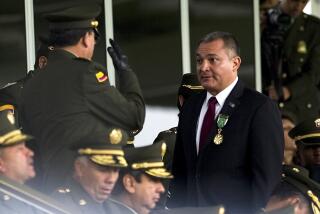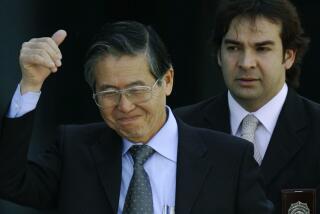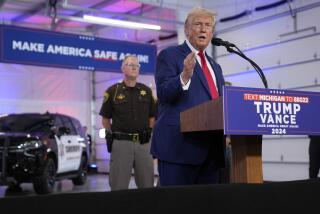‘Constitutional Coup’ Ended Estrada’s Rule
MANILA — The ouster of Joseph Estrada as president of the Philippines this weekend was the result of a “constitutional coup” sparked by retired and active generals who planned to arrest him, organizers of the plot said Sunday.
The group of generals, siding with hundreds of thousands of anti-Estrada protesters, was set to deploy troops on the streets Saturday, seize the president and arrest more than 50 of his allies, the plotters said.
But events unfolded more quickly than planned Friday when Armed Forces Chief of Staff Gen. Angelo Reyes learned that the coup attempt was imminent. He defected to the opposition, leaving the president without military backing and prompting the government’s collapse.
“The Philippine people like to call it ‘people power,’ but in fact it was a coup,” said retired air force Gen. Ed Abenina, one of the ringleaders of the plot. “It was the overthrow of the government.”
The military plays a pivotal role in Philippine politics because the nation’s constitution, by implication, gives it the power to remove a president who is corrupt, incompetent or endangering the nation.
Retired Gen. Fortunato Abat, a former defense secretary, army chief and ambassador to China, said he and his co-conspirators had been plotting Estrada’s ouster for months.
In November, he said, they told Reyes in broad terms of their plan.
The conspirators could have been arrested and jailed for sedition, but the armed forces chief apparently never told the president of the plot or ordered the generals’ arrest.
Reyes could not be reached for comment Sunday.
The plotters waited until Friday morning to tell Vice President Gloria Macapagal Arroyo that they planned to stage the coup Saturday and would install her as president.
She reportedly asked if the plot was irreversible.
“I told her, ‘It is either you or someone else,’ ” said Abenina, who served five years in prison for leading unsuccessful coups in 1987 and 1989 against then-President Corazon Aquino.
Arroyo did not tell the president of the impending ouster but apparently informed Reyes, triggering the decision of the armed forces chief to defect.
Within hours, he had joined the protesters at a mass rally here in the capital.
“On behalf of the 130,000 members of the armed forces, I would like to announce we are withdrawing support from the president,” he said.
The Philippines is famous for its “people power” revolution of 1986, which ousted dictator Ferdinand E. Marcos. What is less well remembered is that the armed forces played a crucial role in getting rid of Marcos.
The 1986 upheaval began when top military officials publicly broke with Marcos and holed up at a military base in Manila. Members of the public began gathering outside the base to protect them from arrest. Over a period of days, 2 million people filled the streets, army units began siding with the protesters, and the Marcos regime fell.
After opposition leader Aquino was sworn in as his successor, the country adopted a new constitution enshrining the military as “the protector of the people and the state.”
That clause has been widely interpreted as granting the armed forces the power to intervene and oust a democratically elected president who, as Abat put it, “threatens the very existence of our people, our country and our institutions.”
Some officers have taken this responsibility to heart. Under Aquino, there were seven coup attempts altogether. The next president, former Defense Secretary Fidel V. Ramos, a retired general and hero of 1986, fared better. The armed forces never attempted to oust him.
But less than two years after Estrada, a former action movie star, succeeded Ramos, the military turned against him.
Although Estrada received more votes than any other Philippine president, the coup plotters believed the hard-drinking gambler and womanizer was destroying the country.
Some of the conspirators began planning more than a year ago to oust Estrada, and they set a target date of December. But the schedule kept slipping because of problems with logistics, such as establishing communications links and obtaining fuel for the tanks and aircraft the plotters planned to use.
After evidence emerged that the president had illegally pocketed millions of dollars, he was impeached by the House of Representatives on four corruption charges. His trial in the Senate began in December, but it looked as if he controlled enough votes there to escape conviction.
Abat began openly campaigning for Estrada’s ouster and gave speeches explaining how the military could legally remove him from office.
“To focus merely on impeachment as the only constitutional process which we must entertain is to misinterpret the constitution,” he said in a December speech to a group of officers. “I have made my choice. You must make yours.”
Abat noted that military leaders could remove the president by confronting him and ordering him to step down or by withdrawing the armed forces’ support for him.
Worried that an acquittal in Congress would give Estrada new legitimacy, the conspirators planned to oust him before his impeachment trial was expected to end, on Feb. 12.
Then, on Tuesday, the trial came to an abrupt halt when the Senate refused to consider evidence that Estrada had allegedly put more than $63 million in a bank account under a false name.
The decision sparked mass demonstrations near the site of the 1986 “people power” protests and gave the plotters the chance they needed. The protesters could not bring down Estrada by themselves, but their daily rallies could enhance the moral authority of the military to step in.
“We were grateful the protests took place. But even without the protests, we had a plan,” said Homobono Adaza, a former congressman and provincial governor who helped organize the ouster.
The scheme included moving three battalions of marines and dozens of tanks to the protest site in the early hours of Saturday while arresting the president and supporters who posed a threat.
As armed forces chief of staff, Reyes was in the most influential position to decide who should be president.
If he had attempted to stop the generals from carrying out their plan, the plotters said, they would have placed him under house arrest like other key Estrada backers.
Of all the people who turned against him, it was Reyes who most disappointed Estrada.
“I am most sad because I trusted Gen. Reyes,” he told a reporter shortly before leaving the presidential palace.
When Reyes joined the opposition, Defense Secretary Orlando Mercado and a number of top generals went with him.
“This is indeed a coup, a constitutional coup, because you have military forces going against the chain of command,” Mercado said later.
The plotters estimated that the opposition had won effective control over 80% of the armed forces by the time Arroyo was sworn in Saturday afternoon.
In a series of appearances over the weekend, Arroyo thanked the protesters, the Roman Catholic Church, business leaders and God for her accession to the presidency. But she distanced herself as much as possible from the military and hardly mentioned it at all.
“I would like to pay tribute to the generals who threw their support behind us,” she said at one point. “They are asking for a healing process.”
Last fall, Estrada didn’t help himself with the retired generals who were even then planning his ouster.
When a group of retired officers called for his resignation, Estrada dismissed them as old and useless. Among those he offended was Abat, who was inspired to work even harder.
“He didn’t know about the traditions of the military,” said the 75-year-old Abat. “He didn’t realize that those on active duty once worked for the retired ones.”
More to Read
Sign up for Essential California
The most important California stories and recommendations in your inbox every morning.
You may occasionally receive promotional content from the Los Angeles Times.










